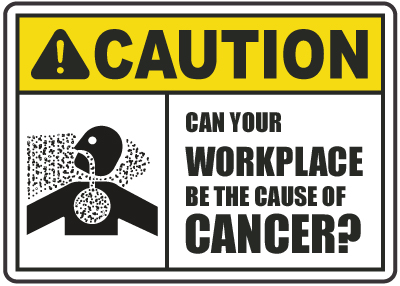Article written by Gerard M. Antoine, MD
The World Health Organization reports that Cancer is a leading cause of death worldwide, with 12.7 million new cases and 7.6 million deaths in 2008. Occupational cancers cause in 1.3 million deaths globally each year.
Over 100 chemical or biological agents are known or probable human carcinogensA carcinogen is any substance that is an agent directly involved in causing cancer. The International Agency for Research on Cancer (IARC, 2002) has classified over 100 chemical or biological agents as known or probable human carcinogens, and exposures to many of these carcinogens (e.g. asbestos, cadmium and benzene) occur in occupational settings. Occupational exposure is defined as any contact between the human body and a potentially harmful agent or environment in the workplace.
Specific exposures are related to the type of work that people do (i.e. occupation), where they do it and the measures that are taken to limit exposures. The probability that a worker will develop cancer is influenced by the total dose of carcinogen received, the potency of the carcinogen, the presence of other exposures (notably tobacco smoking), and individual susceptibility.
Exposure to carcinogens can lead to changes at the cellular levelExcess exposure to carcinogens can lead to changes at the cellular level, resulting in the uncontrolled growth of abnormal cells that invade and destroy normal tissues in the lung, blood system, etc. Exposure to a carcinogen does not necessarily mean that you will develop cancer. The most common types of occupational cancers are lung cancer, bladder cancer and mesothelioma.
All occupational cancers are preventable. Regulatory control, worker education, and attention to safe occupational practices are needed to minimize exposure to occupational carcinogens.
| Type of Cancer | Occupational Exposure | Occupation |
| Lung | Second hand smoke |
|
| Bladder | Aaromatic amines, benzidine dyes and methylene-bis-orthochloroaniline |
|
| Bladder | Asbestos |
|
Tobacco smoking increases the risk of many occupational carcinogens. Among workers exposed to asbestos, smokers have a lung cancer risk many times greater than that of people who are exposed to asbestos and do not smoke. Quitting the use of tobacco can dramatically reduce a worker’s risk of developing occupationally caused cancers.
Sources:
-
Boffetta, P, et al. Current perspectives on occupational cancer risks. International journal of occupational and environmental health, Vol. 1, no. 4 (1995). p. 315-325
-
World Health Organization Fact sheet N°350. March 2011
-
Carex: Most Common Occupational Exposures to IARC Agents – Ontario/British Columbia, Canada 2001 Census Data – 09-Jan-08
-
Occupational Medicine Clinical Update – Occupational Carcinogens – What makes it on the list. Fall 2005 – Occupational Health Workers for Ontario Workers Inc. (OHCOW)
-
American Cancer Society, Inc. 2007, No.300214-Rev.02/14

